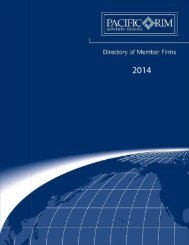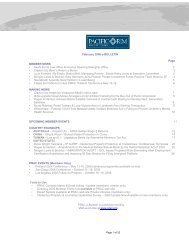A Guide to the Law of Securitisation in Australia - Clayton Utz
A Guide to the Law of Securitisation in Australia - Clayton Utz
A Guide to the Law of Securitisation in Australia - Clayton Utz
- No tags were found...
Create successful ePaper yourself
Turn your PDF publications into a flip-book with our unique Google optimized e-Paper software.
From 1 January 2005, however, <strong>Australia</strong> has adoptedInternational F<strong>in</strong>ancial Report<strong>in</strong>g Standards (IFRS) and this hasf<strong>in</strong>ally allowed <strong>the</strong> account<strong>in</strong>g firms <strong>to</strong> take a uniform view <strong>of</strong>transactions across jurisdictions. As a result, it is now moredifficult for ADIs <strong>to</strong> comply with <strong>the</strong> separation requirements <strong>of</strong>APS 120 (and <strong>to</strong> a lesser extent <strong>the</strong> clean sale requirementsdiscussed below).However, APRA has stated that it will not be mak<strong>in</strong>g any IFRSrelatedchanges <strong>to</strong> its prudential standards before 1 July 2005and until <strong>the</strong>n <strong>the</strong> separation requirements (and clean salerequirements discussed below) should cont<strong>in</strong>ue <strong>to</strong> be applied for<strong>the</strong> purposes <strong>of</strong> APS 120 based on <strong>the</strong> account<strong>in</strong>g standards <strong>in</strong>place as at 31 December 2004.7.1.3 Provision <strong>of</strong> facilities by ADIsAPS 120 permits an ADI <strong>to</strong> provide various facilities and services<strong>to</strong> a securitisation vehicle without adverse capital consequencesif certa<strong>in</strong> requirements are satisfied. The treatment <strong>of</strong> this areais exhaustive and covers, for example, ADIs provid<strong>in</strong>g creditenhancements, liquidity facilities, underwrit<strong>in</strong>g commitments,advice <strong>to</strong> <strong>in</strong>ves<strong>to</strong>rs, <strong>the</strong> purchase <strong>of</strong> securities, <strong>the</strong> purchase (orrepurchase) <strong>of</strong> assets from a securitisation vehicle, <strong>the</strong> provision<strong>of</strong> management and servic<strong>in</strong>g functions and <strong>the</strong> enter<strong>in</strong>g <strong>in</strong><strong>to</strong> <strong>of</strong>derivatives with a securitisation vehicle.Although <strong>the</strong> requirements differ depend<strong>in</strong>g on <strong>the</strong> type <strong>of</strong>facility or service <strong>to</strong> be provided, <strong>the</strong>re are some broadly uniformpreconditions.In particular, a facility or service should be provided on an arm’slength basis and on market terms and conditions and should besubject <strong>to</strong> <strong>the</strong> ADI’s normal <strong>in</strong>ternal approval procedures. Thereshould also be no recourse <strong>to</strong> <strong>the</strong> ADI beyond its fixedcontractual obligations and <strong>the</strong> ADI should obta<strong>in</strong> a legal op<strong>in</strong>ion<strong>to</strong> this effect.The treatment by APS 120 <strong>of</strong> credit enhancements warrantsparticular comment. In this context, <strong>the</strong> relevant provisions applynot only <strong>to</strong> traditional credit enhancements but also <strong>in</strong>clude o<strong>the</strong>rtypes <strong>of</strong> facilities (eg. some liquidity facilities or where an ADIfunds a spread or reserve account). APS 120 divides creditenhancements <strong>in</strong><strong>to</strong> two categories: a first loss facility and asecond loss facility. As its name suggests, a first loss facilityrepresents <strong>the</strong> first level <strong>of</strong> credit enhancement <strong>to</strong> asecuritisation vehicle. Because <strong>of</strong> <strong>the</strong> greater risks associatedwith a first loss facility, an ADI provid<strong>in</strong>g this should, for capitaladequacy purposes, deduct <strong>the</strong> full amount <strong>of</strong> <strong>the</strong> facility from itscapital base, up <strong>to</strong> a maximum <strong>of</strong> <strong>the</strong> amount <strong>of</strong> capital that itwould normally be required <strong>to</strong> hold aga<strong>in</strong>st <strong>the</strong> full value <strong>of</strong> <strong>the</strong>securities issued by <strong>the</strong> vehicle. On <strong>the</strong> o<strong>the</strong>r hand, a second lossfacility can be treated as a normal credit facility for capitaladequacy purposes. A second loss facility credit enhancementshould be protected by a “substantial” first loss facility andshould only be capable <strong>of</strong> be<strong>in</strong>g drawn after <strong>the</strong> first loss facilityhas been completely exhausted. In this context, “substantial”should be sufficient <strong>to</strong> cover a multiple <strong>of</strong> his<strong>to</strong>rical or worst caselosses.7.1.4 Transfer <strong>of</strong> assetsAPS 120 sets down <strong>the</strong> conditions that must be satisfied if anADI wishes <strong>to</strong> be relieved from <strong>the</strong> requirement <strong>to</strong> hold capitalaga<strong>in</strong>st assets it has sold <strong>to</strong> a securitisation vehicle. Significantly,APRA states that <strong>in</strong> supply<strong>in</strong>g assets <strong>to</strong> a securitisation vehicle,ADIs should ensure that this will not lead <strong>to</strong> a deterioration <strong>in</strong><strong>the</strong> average quality <strong>of</strong> assets rema<strong>in</strong><strong>in</strong>g on its balance sheet.In order <strong>to</strong> qualify, a transfer <strong>of</strong> assets must be a clean sale.APS 120 sets down a number <strong>of</strong> prerequisites for this <strong>to</strong> occur.In particular, <strong>the</strong> beneficial ownership <strong>of</strong> <strong>the</strong> assets must betransferred (although <strong>the</strong> ADI may reta<strong>in</strong> legal ownership) and<strong>the</strong> risks and rewards <strong>of</strong> <strong>the</strong> assets must also be fully transferred<strong>to</strong> <strong>the</strong> vehicle. External audit and appropriately qualified <strong>in</strong>ternalor external legal op<strong>in</strong>ions should be obta<strong>in</strong>ed confirm<strong>in</strong>gcompliance with <strong>the</strong>se and various additional requirements.In recognition <strong>of</strong> some structures, APS 120 permits an ADI <strong>to</strong>cont<strong>in</strong>ue <strong>to</strong> receive surplus or excess <strong>in</strong>come generated bysecuritised assets and, where <strong>the</strong> assets are revolv<strong>in</strong>g, <strong>to</strong> reta<strong>in</strong>an <strong>in</strong>terest <strong>in</strong> <strong>the</strong>m, provided certa<strong>in</strong> additional requirements aresatisfied.As noted above, <strong>the</strong> <strong>in</strong>troduction <strong>of</strong> IFRS has made <strong>the</strong>derecognition tests set out <strong>in</strong> <strong>the</strong> <strong>Australia</strong>n account<strong>in</strong>gstandards more difficult <strong>to</strong> satisfy but APRA is still consider<strong>in</strong>g<strong>the</strong> implications <strong>of</strong> IFRS for APS 120 and until it does so APS 120will cont<strong>in</strong>ue <strong>to</strong> apply on <strong>the</strong> basis <strong>of</strong> account<strong>in</strong>g standards <strong>in</strong>place as at 31 December 2004.7.1.5 APRA’s new conglomerate capital adequacy regimeAPRA <strong>in</strong>troduced revised prudential standards for ADIconglomerates on 1 July 2003. Amongst <strong>the</strong> revised prudentialstandards is Prudential Standard APS 222 – Associations withRelated Entities which can impact upon securitisationtransactions <strong>in</strong> which an ADI provides fund<strong>in</strong>g <strong>to</strong> <strong>the</strong>securitisation vehicle. Under APS 222, an ADI’s <strong>in</strong>tra-groupexposure is subject <strong>to</strong> certa<strong>in</strong> limits prescribed by APRA. Suchlimits will not apply <strong>to</strong> an ADI’s exposure <strong>to</strong> subsidiaries whichform part <strong>of</strong> closely held companies that are part <strong>of</strong> <strong>the</strong> ExtendedLicensed Entity (ELE). Whe<strong>the</strong>r a subsidiary is eligible for45






